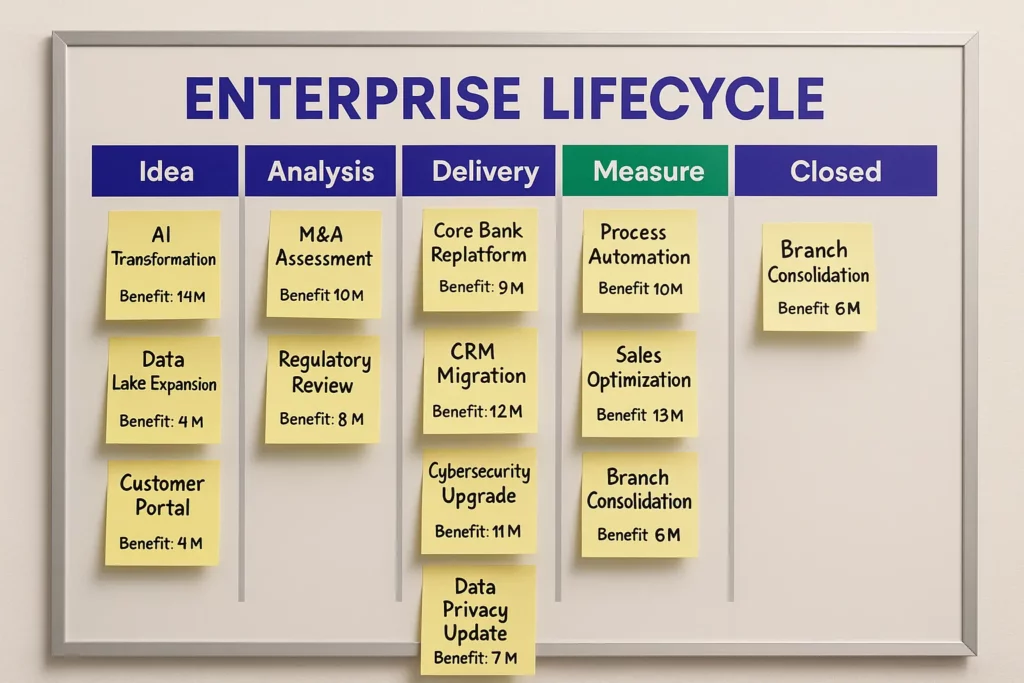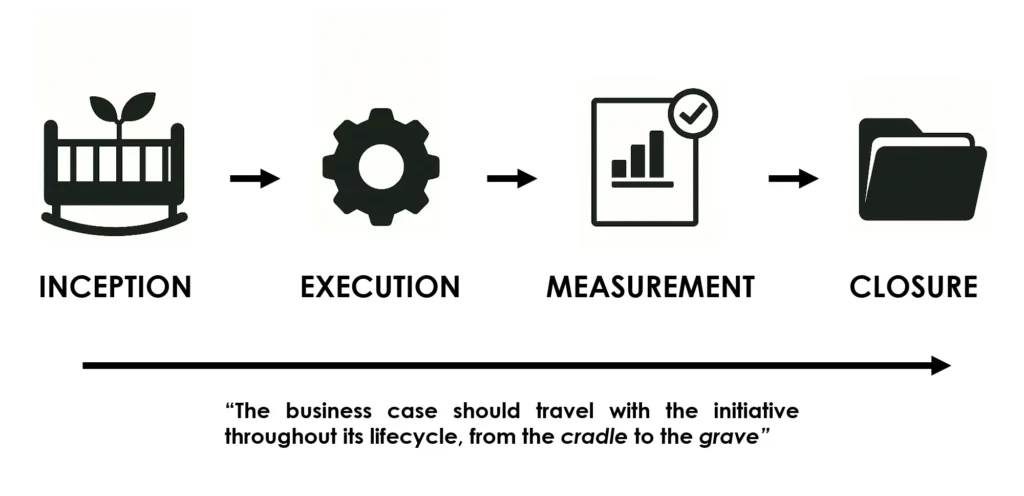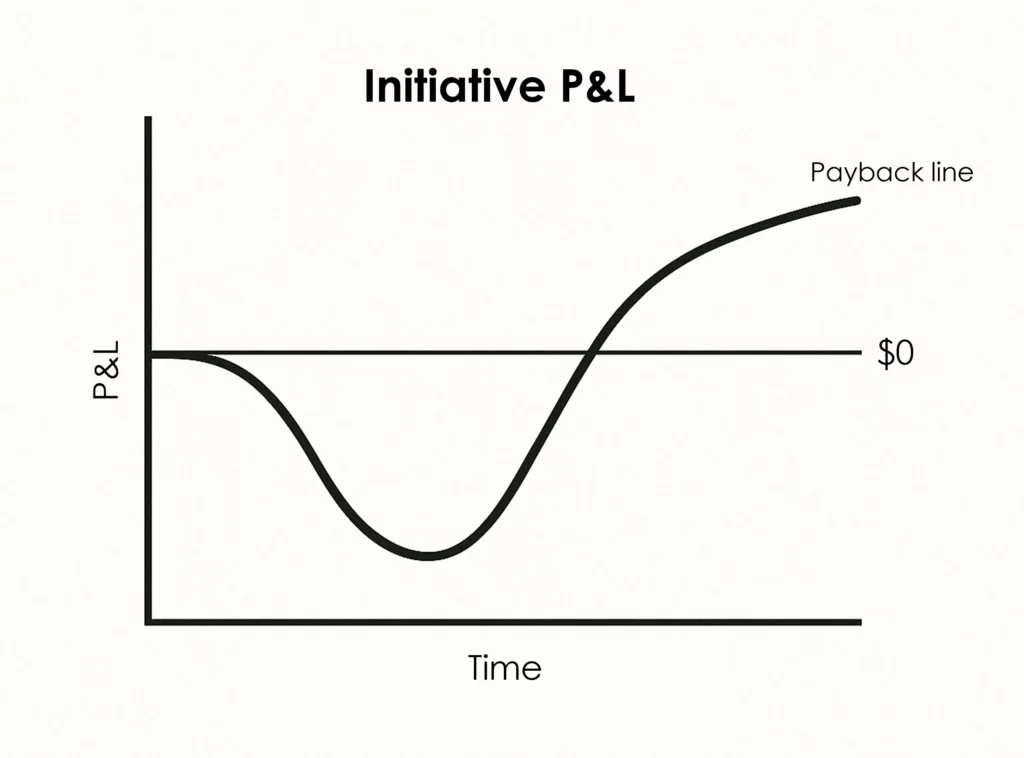image:intro

Most organizations readily acknowledge the importance of benefits realization – yet surprisingly few consistently achieve it. The central issue isn't recognizing value's importance but systematically embedding practices that hold leaders accountable for delivering sustained, measurable results. Typically, benefits realization falters when the original enthusiasm for a completed project or epic fades away – teams move onto new initiatives without ever fully validating or tracking the long-term benefits.
Here are five practical steps – fit for agile or waterfall – that ensure benefits are delivered, not just promised.
1. Measurement as a stage
A primary reason organizations struggle with benefits realization is that attention dissipates once a project, initiative, or epic is marked as completed. Project teams or agile squads become excited by the next deliverable, leaving behind partially realized benefits.
image:medium

Introducing a formal "Measurement" stage ensures sustained attention. After initial delivery, initiatives enter this stage to validate and track their long-term benefits, remaining there potentially for years until formally approved for closure by an executive – usually the CFO (or their delegate). This creates transparency and genuine accountability. Executives carefully consider whether to formally close a project, particularly when this might publicly recognize significant shortfalls.
It is critical for the success of this stage that it is paired with a regular executive governance forum, see point 2 for more.
2. Quarterly Exec-led Benefits Reviews
If benefits realization sits with middle management, it’s already dead. It must be visibly owned by executives, or it becomes a box-ticking exercise. Executive leadership must visibly drive this process to maintain strategic focus and accountability. Integrating benefits reviews into existing Quarterly Business Reviews (QBRs) – chaired directly by senior executives such as the CFO or COO – ensures rigorous scrutiny, prevents double-counting, and discourages overly optimistic reporting.
This executive-led focus helps embed a culture of benefits realization throughout the organization. It reinforces the principle that delivery is only half the story – real success lies in what the initiative ultimately achieves in terms of measurable outcomes.
The purpose of the forum is to review progress against the live P&L of all initiatives currently in the "Measurement" stage. These P&Ls reflect ongoing benefit realization and incurred costs. Initiatives may request approval to move to "Closed," which effectively closes the account for that initiative – crystallizing the benefits delivered and the costs borne. This formal closure point adds a layer of discipline and accountability that many organizations currently lack.
All initiative-level P&Ls should be stored and retained. Over time, these can be aggregated and compared across executives and benefit owners to evaluate relative performance, reveal patterns in delivery effectiveness, and inform future investment decisions. This structured approach not only strengthens benefit accountability but also supports strategic learning across the portfolio.
3. Assign Benefits Ownership
Clearly identifying who owns benefit realization within business cases is critical. While an "Accountable Executive" typically oversees delivery, naming a dedicated "Benefits Owner" ensures there is a single individual responsible for actively driving and tracking benefits over time. This distinction encourages proactive benefit assessment, continuous improvement, and strategic alignment – long after the initial delivery phase is complete.
Crucially, the Benefits Owner should be someone in a position to actually influence and realise the benefit. For revenue-generating initiatives, this will almost always need to be someone in a front-line business function- typically someone with customer, client, or user-facing accountability. Without this, the benefit often becomes detached from those who are best placed to realise it.
For cost-saving initiatives, the realization pathway can vary. In some cases, the benefit sits with a business function or operations lead. In others – particularly where technology plays a central role in driving efficiency – the CIO or a delegate within the CIO’s function may be the most appropriate owner. What matters is that the individual is not just a sponsor or stakeholder, but someone with genuine control or influence over the levers required to realise the benefit.
Avoid treating benefit ownership as a formality or administrative checkbox. It should be an active role with real responsibility, reflected in governance, reporting, and ideally, performance incentives.
4. Systematize Business Cases
The business case for an initiative should travel with it from the cradle (inception) to the grave (closure).
Relying on Word documents or spreadsheets stored in shared drives or SharePoint can undermine effective benefit realization. These documents often become static snapshots, failing to evolve meaningfully through the lifecycle of initiatives. They do not act as a reliable "patient record," tracking all developments from inception through delivery and into benefit realization.
image:medium

Transitioning to structured, purpose-built digital systems creates robust, living records of your business cases. This approach provides:
- Continuous transparency and real-time analytics
- Effective version control
- Centralized and auditable records
- Persistent visibility of benefits outcomes
Systematization ensures your business cases actively guide organizational governance, becoming the single authoritative source for benefit realization and accountability.
5. Establish Initiative P&L
Systematizing your business cases lays the foundation for a more rigorous and meaningful way to track value: the Initiative P&L. Once business cases are structured and persistent – rather than lost in disconnected Word documents or spreadsheets – you can begin to treat each initiative as a financial entity with its own evolving Profit & Loss profile.
image:medium

In this model, benefits from previously delivered initiatives contribute positively to the "P" (profit or cost savings), while current or in-flight initiatives contribute to the "L" (costs). This helps organizations shift their mindset: initiatives are no longer judged solely on delivery milestones but on the long-term value they generate or enable.
For example, a project completed last year should still be contributing measurable financial impact this year – revenue uplift, cost reduction, or risk mitigation – whereas current initiatives are still largely investment. This perspective fosters a culture of financial continuity and accountability, where value creation is tracked over time, not just at the moment of go-live.
Moreover, by storing and aggregating these Initiative P&Ls across the organization, leadership gains a powerful lens to compare relative performance between business areas, functions, or executive peer groups. This not only supports better investment decisions, but also creates strategic clarity around which types of initiatives consistently deliver measurable value.
In regulated environments, it's important to distinguish initiatives that are compliance-driven or mandatory. While these may not carry direct financial upside, clearly ringfencing them ensures the remaining portfolio is focused on delivering real, attributable business benefit.
💡 A replatforming initiative completed last year may now be enabling 15% faster customer onboarding – translating to measurable revenue uplift. That’s value. Meanwhile, a new ESG compliance project in-flight is pure cost – until it clears regulatory risk. Together, they form a living Initiative P&L.
Cultivating a Culture of Benefits Realization
Ultimately, lasting benefit realization demands a cultural transformation. Senior executives must actively champion the long-term measurement of outcomes, embedding benefit realization into organizational expectations and incentives. Teams at every level should recognize the importance of sustained benefit tracking as an integral part of their daily roles.
When an organization collectively prioritizes benefits realization, measurable outcomes become the expected standard rather than an optimistic exception.
Conclusion
By embedding these five practices into your organization's fabric, you shift beyond superficial claims of "value" towards authentic, lasting, measurable outcomes. Benefits realization, properly structured and culturally supported, isn't just good governance—it's fundamental to sustainable organizational growth and strategic credibility.

